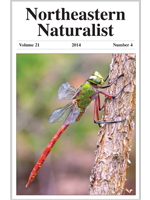The arrival of a novel predator in an ecosystem necessitates many wildlife-management decisions that should be based on sound demographic data. Canis latrans (Coyote) has experienced a dramatic range expansion across North America since the early 19th century, completing its colonization of the continental US in the mid-Atlantic region over the past 20 years. Their arrival in the suburbs of Washington, DC, has generated much public attention, and demonstrated a need for demographic information about this species. To address the challenges of surveying an elusive animal, we used fecal DNA to describe the population genetics and demographics of a newly colonized Coyote population at Marine Corps Base Quantico (MCBQ) in northern Virginia. We collected 331 scats over a period of 2 years at MCBQ, resulting in identification of 23 unique individual Coyotes and 41 total Coyote captures that were analyzed using spatial capture—recapture models. We found evidence of colonization by multiple genetic lineages and a low population density of 0.047 individuals/km2. Importantly, this study incorporates a new class of models on individual animals identified by genotype data derived from fecal DNA and demonstrates the utility of these models in surveying elusive animals.
How to translate text using browser tools
1 March 2015
Using Fecal DNA and Spatial Capture-Recapture to Characterize a Recent Coyote Colonization
Christine A. Bozarth,
Beth Gardner,
Larry L. Rockwood,
Jesús E. Maldonado
ACCESS THE FULL ARTICLE

Northeastern Naturalist
Vol. 22 • No. 1
March 2015
Vol. 22 • No. 1
March 2015




